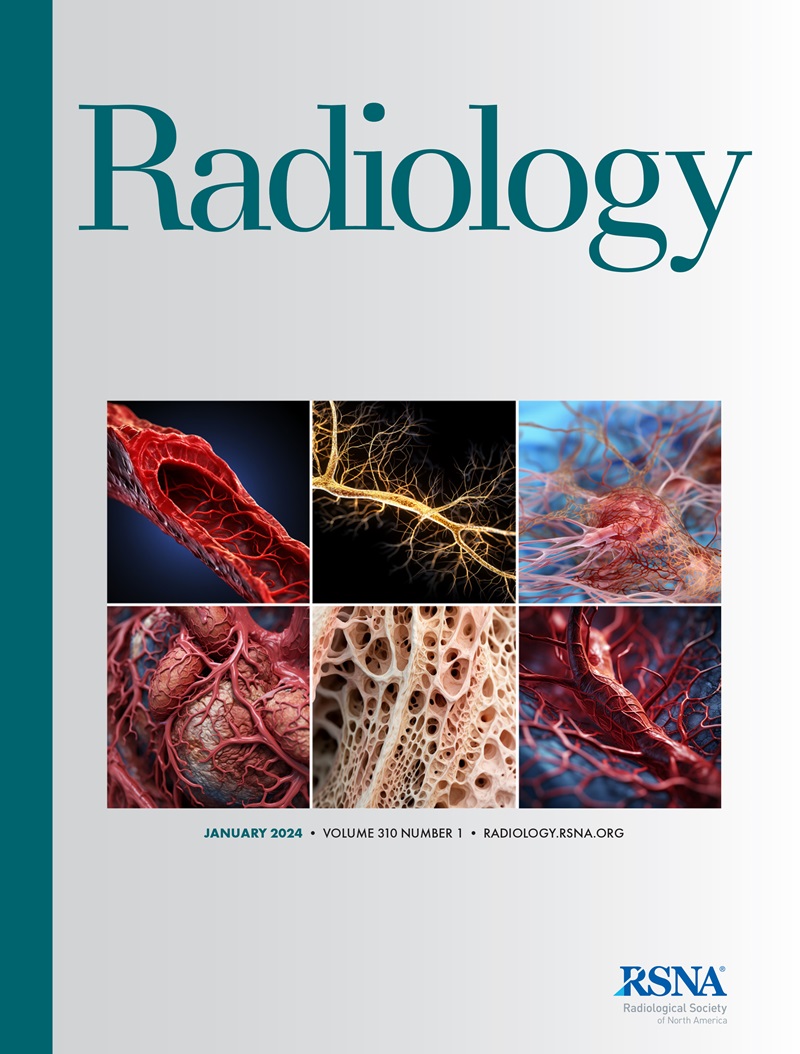Endovascular Thrombectomy for Acute Vertebrobasilar Artery Occlusion with Mild Deficits: A Multicenter Registry Study.
IF 12.1
1区 医学
Q1 RADIOLOGY, NUCLEAR MEDICINE & MEDICAL IMAGING
Wen Sun, Pan Zhang, Miaomiao Hu, Jinghui Zhong, Wanqiu Zhang, Yiran Dong, Xian Chao, Hongmei Huang, Jie Wen, Lulu Xiao, Yingjie Xu
求助PDF
{"title":"Endovascular Thrombectomy for Acute Vertebrobasilar Artery Occlusion with Mild Deficits: A Multicenter Registry Study.","authors":"Wen Sun, Pan Zhang, Miaomiao Hu, Jinghui Zhong, Wanqiu Zhang, Yiran Dong, Xian Chao, Hongmei Huang, Jie Wen, Lulu Xiao, Yingjie Xu","doi":"10.1148/radiol.240728","DOIUrl":null,"url":null,"abstract":"<p><p>Background Endovascular thrombectomy (EVT) is an effective method for vertebrobasilar artery occlusion (VBAO) in patients with moderate to severe deficits but has unclear benefits in patients with low National Institutes of Health Stroke Scale (NIHSS) scores at hospital admission. Purpose To compare the clinical outcomes of best medical management (BMM) alone versus BMM and early EVT (door-to-puncture time [DPT] ≤ 120 minutes) versus BMM and late EVT (DPT > 120 minutes) in patients with VBAO who have NIHSS scores of 10 or less at admission. Materials and Methods This retrospective study evaluated patients with VBAO and admission NIHSS score of 10 or less who were seen at 65 stroke centers in China from December 2015 to June 2022. The primary outcome was whether the patient achieved a favorable functional outcome (a modified Rankin scale [mRS] score of 0-3 at 90 days). Adjusted multivariable logistic regression analyses were used to assess the association between treatment (BMM alone vs early EVT and BMM vs late EVT and BMM) and outcomes. Results Among 1365 patients (mean age ± SD, 65 years ± 12; 951 male) with VBAO and an NIHSS score of 10 or less at admission, 489 patients (35.8%) received EVT. Of these, 382 (78.1%) received early EVT, and 107 (21.9%) received late EVT. After adjustment for confounders, compared with BMM alone, early EVT plus BMM was associated with increased rates of favorable functional outcome (odds ratio [OR], 1.41 [95% CI: 1.05, 1.87]; <i>P</i> = .02), whereas late EVT plus BMM did not outperform BMM alone (OR, 0.83 [95% CI: 0.54, 1.28]; <i>P</i> = .39). Conclusion In patients with VBAO admitted with an NIHSS score of 10 or less, early EVT (DPT ≤ 120 minutes) combined with BMM outperformed BMM alone, whereas late EVT (DPT > 120 minutes) combined with BMM did not outperform BMM alone. © RSNA, 2025 <i>Supplemental material is available for this article.</i></p>","PeriodicalId":20896,"journal":{"name":"Radiology","volume":"314 1","pages":"e240728"},"PeriodicalIF":12.1000,"publicationDate":"2025-01-01","publicationTypes":"Journal Article","fieldsOfStudy":null,"isOpenAccess":false,"openAccessPdf":"","citationCount":"0","resultStr":null,"platform":"Semanticscholar","paperid":null,"PeriodicalName":"Radiology","FirstCategoryId":"3","ListUrlMain":"https://doi.org/10.1148/radiol.240728","RegionNum":1,"RegionCategory":"医学","ArticlePicture":[],"TitleCN":null,"AbstractTextCN":null,"PMCID":null,"EPubDate":"","PubModel":"","JCR":"Q1","JCRName":"RADIOLOGY, NUCLEAR MEDICINE & MEDICAL IMAGING","Score":null,"Total":0}
引用次数: 0
引用
批量引用
Abstract
Background Endovascular thrombectomy (EVT) is an effective method for vertebrobasilar artery occlusion (VBAO) in patients with moderate to severe deficits but has unclear benefits in patients with low National Institutes of Health Stroke Scale (NIHSS) scores at hospital admission. Purpose To compare the clinical outcomes of best medical management (BMM) alone versus BMM and early EVT (door-to-puncture time [DPT] ≤ 120 minutes) versus BMM and late EVT (DPT > 120 minutes) in patients with VBAO who have NIHSS scores of 10 or less at admission. Materials and Methods This retrospective study evaluated patients with VBAO and admission NIHSS score of 10 or less who were seen at 65 stroke centers in China from December 2015 to June 2022. The primary outcome was whether the patient achieved a favorable functional outcome (a modified Rankin scale [mRS] score of 0-3 at 90 days). Adjusted multivariable logistic regression analyses were used to assess the association between treatment (BMM alone vs early EVT and BMM vs late EVT and BMM) and outcomes. Results Among 1365 patients (mean age ± SD, 65 years ± 12; 951 male) with VBAO and an NIHSS score of 10 or less at admission, 489 patients (35.8%) received EVT. Of these, 382 (78.1%) received early EVT, and 107 (21.9%) received late EVT. After adjustment for confounders, compared with BMM alone, early EVT plus BMM was associated with increased rates of favorable functional outcome (odds ratio [OR], 1.41 [95% CI: 1.05, 1.87]; P = .02), whereas late EVT plus BMM did not outperform BMM alone (OR, 0.83 [95% CI: 0.54, 1.28]; P = .39). Conclusion In patients with VBAO admitted with an NIHSS score of 10 or less, early EVT (DPT ≤ 120 minutes) combined with BMM outperformed BMM alone, whereas late EVT (DPT > 120 minutes) combined with BMM did not outperform BMM alone. © RSNA, 2025 Supplemental material is available for this article.
急性椎基底动脉闭塞伴轻度缺陷的血管内取栓:一项多中心注册研究。
血管内血栓切除术(EVT)是治疗中度至重度椎基底动脉闭塞(VBAO)患者的有效方法,但对入院时美国国立卫生研究院卒中量表(NIHSS)评分较低的患者的益处尚不清楚。目的比较入院时NIHSS评分在10分及以下的VBAO患者,最佳医疗管理(BMM)与最佳医疗管理(BMM) +早期EVT(门到穿刺时间[DPT]≤120分钟)与最佳医疗管理(BMM) +晚期EVT (DPT bb0 120分钟)的临床结果。材料与方法本回顾性研究评估了2015年12月至2022年6月在中国65个卒中中心就诊的VBAO患者和入院时NIHSS评分在10分或以下的患者。主要结局是患者是否达到了良好的功能结局(90天时修改的Rankin量表[mRS]评分为0-3)。采用调整后的多变量logistic回归分析来评估治疗(BMM单独与早期EVT、BMM与晚期EVT合并BMM)与结果之间的关系。结果1365例患者(平均年龄±SD, 65岁±12岁;入院时NIHSS评分在10分及以下的VBAO患者951例(男性),489例(35.8%)接受EVT治疗。其中382例(78.1%)接受早期EVT, 107例(21.9%)接受晚期EVT。调整混杂因素后,与单独BMM相比,早期EVT加BMM与良好功能结局的发生率增加相关(优势比[OR], 1.41 [95% CI: 1.05, 1.87];P = .02),而晚期EVT + BMM并不优于单独BMM (OR, 0.83 [95% CI: 0.54, 1.28];P = .39)。结论在NIHSS评分≤10分的VBAO患者中,早期EVT (DPT≤120分钟)联合BMM优于单独BMM,而晚期EVT (DPT≤120分钟)联合BMM不优于单独BMM。©RSNA, 2025本文可获得补充材料。
本文章由计算机程序翻译,如有差异,请以英文原文为准。
来源期刊
期刊介绍:
Published regularly since 1923 by the Radiological Society of North America (RSNA), Radiology has long been recognized as the authoritative reference for the most current, clinically relevant and highest quality research in the field of radiology. Each month the journal publishes approximately 240 pages of peer-reviewed original research, authoritative reviews, well-balanced commentary on significant articles, and expert opinion on new techniques and technologies.
Radiology publishes cutting edge and impactful imaging research articles in radiology and medical imaging in order to help improve human health.

 求助内容:
求助内容: 应助结果提醒方式:
应助结果提醒方式:


